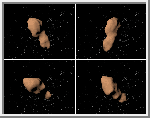|
COMETS EARTH JUPITER KUIPER BELT MARS MERCURY METEORITES NEPTUNE OORT CLOUD PLUTO SATURN SOLAR SYSTEM SPACE SUN URANUS VENUS ORDER PRINTS
PHOTO CATEGORIES SCIENCEVIEWS AMERICAN INDIAN AMPHIBIANS BIRDS BUGS FINE ART FOSSILS THE ISLANDS HISTORICAL PHOTOS MAMMALS OTHER PARKS PLANTS RELIGIOUS REPTILES SCIENCEVIEWS PRINTS
|
Related Document
Download Options
These images show a computer model of the Earth-orbit-crossing asteroid 4179 Toutatis. The model was created by Scott Hudson of Washington State University and Steven Ostro of the Jet Propulsion Laboratory using radar data that had been obtained with the Goldstone radar telescope in California and the Arecibo radar telescope in Puerto Rico. The object is about 4.6 kilometers (about 3 miles) long. The resolution of the computer model is about 84 meters. These views of the asteroid show shallow craters, linear ridges, and a deep topographic "neck" whose geologic origin is not known. It may have been sculpted by impacts into a single, coherent body, or Toutatis might actually consist of two separate objects that came together in a gentle collision. Toutatis has one of the strangest rotation states yet observed in the solar system. Instead of spinning about a single axis as do the planets and the vast majority of asteroids, it "tumbles" somewhat like a football after a botched pass. Its rotation is the result of two different types of motion with periods of 5.4 and 7.3 Earth days that combine in such a way that Toutatis's orientation with respect to the solar system never repeats. Hudson and Ostro's model appeared in the October 6, 1995 issue of Science. Their work was part of the Planetary Geology and Geophysics Program and the Planetary Astronomy Program of NASA's Office of Space Science and Applications. (Courtesy Scott Hudson, Washington State University) |
